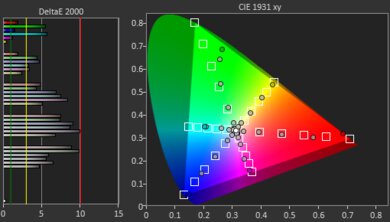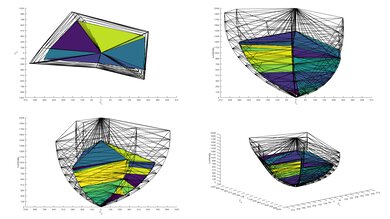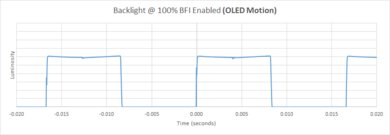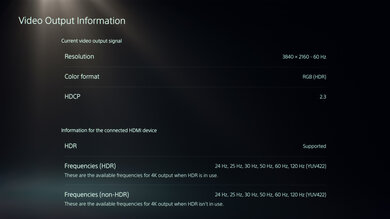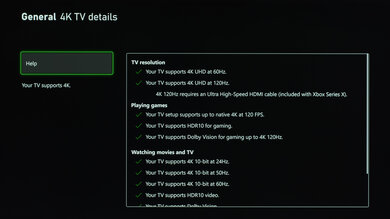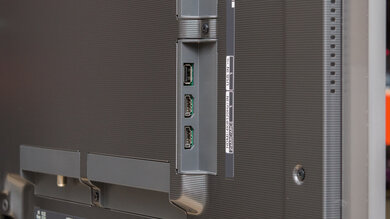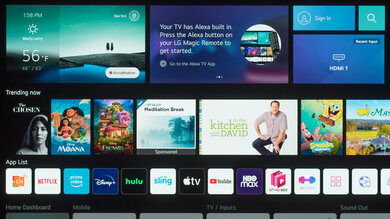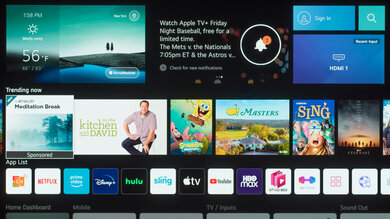The LG G2 OLED is a high-end TV and the successor to the LG G1 OLED. OLED TVs like the G2 are self-emissive, meaning unlike LCD panels found on other TVs, there's no backlight, which allows them to display a nearly-perfect contrast ratio in dark rooms, with deep inky blacks and no distracting blooming or halo-effect around bright objects. This TV has a unique design, and unlike most TVs, it doesn't even come with a stand, as it's designed to be mounted flush to your wall with the included slim wall mount.
Like other LG TVs, it uses the webOS smart interface, which has been slightly refreshed, adding user profiles, among other minor changes. There's a huge focus on gaming features on the G2, including support for GeForce Now. The 'G' lineup isn't as popular as the rest of LG's lineup, as the unique design isn't cheap, but it's LG's highest-end 4k model in 2022, sitting above the more popular LG C2 OLED and below the 8k LG Z2 OLED.
Our Verdict
The LG G2 OLED is a superb TV for most uses. Thanks to its nearly infinite contrast ratio it displays deep blacks with perfect uniformity, making it an exceptional choice for watching movies in a dark room. It's exceptionally bright for an OLED TV, making it a great choice for watching TV shows in a bright room. It also has an incredibly wide viewing angle, so it's a good choice for a wide seating arrangement. It's also an excellent choice for use as a PC monitor. Finally, it has an impressive selection of gaming features, and it delivers a superb gaming experience overall.
- Fantastic reflection handling.
- Image remains accurate at an angle.
- Significantly brighter than previous OLED TVs.
- Aggressive ABL can get distracting with large areas of brightness.
- Some uniformity issues, especially at an angle.
The LG G2 is an excellent choice for watching TV in a bright room. It's bright enough to overcome glare, and it has fantastic reflection handling. The webOS smart interface has a huge selection of streaming apps to choose from, so you're sure to find your favorite content. It has a very wide viewing angle, so you can walk around the house with the TV on and still see an accurate image.
- Fantastic reflection handling.
- Image remains accurate at an angle.
- Aggressive ABL can get distracting with large areas of brightness.
- Some uniformity issues, especially at an angle.
The LG G2 is an excellent TV for watching sports in a bright room. It has fantastic reflection handling and it gets very bright, so it has no issues overcoming glare. It has an extremely fast response time, so fast motion is clear and it's easy to see what's going on. Sadly, there are some uniformity issues, including a pink tint at the edge, and the aggressive brightness limiter causes brightness fluctuations with some content.
- Fantastic reflection handling.
- Image remains accurate at an angle.
- Aggressive ABL can get distracting with large areas of brightness.
- Some uniformity issues, especially at an angle.
The LG G2 OLED delivers a superb gaming experience. It has a nearly-instantaneous response time, resulting in crystal-clear motion, as well as low input lag for a responsive gaming experience. It has a huge selection of additional gaming features, including support for all three variable refresh rate formats, and it's fully compatible with everything the PS5 and Xbox Series X|S have to offer, including 4k @ 120Hz gaming. Its four HDMI ports all support the full bandwidth of HDMI 2.1, great if you have both consoles or also want to connect a PC.
- Fantastic reflection handling.
- Low input lag.
- Impressive gaming features.
- Some uniformity issues, especially at an angle.
The LG G2 OLED is an amazing TV for watching HDR movies in a dark room. The nearly-infinite contrast ratio helps bright highlights really stand out in dark scenes, and there's no distracting blooming around bright objects. It's bright enough to really bring out bright highlights in most scenes, and it tracks the creator's intent well. It has an excellent HDR color gamut and very good HDR color volume, so all but the brightest colors look amazing on this TV.
- Wide color gamut.
- Great peak brightness in HDR.
- Doesn't support DTS passthrough.
- Fast response time results in noticeable stutter.
- Colors aren't as bright as pure white.
The LG G2 OLED delivers a fantastic HDR gaming experience. It has an extremely quick response time and low input lag, and it has a huge selection of gaming features. It delivers an incredible HDR experience as well, with a nearly infinite contrast ratio and high peak brightness, so bright highlights stand out the way they should. It's fully compatible with everything the latest consoles have to offer, including 4k @ 120Hz gaming with HDR, and all four HDMI ports support the full bandwidth of HDMI 2.1, which is great if you have both consoles or a PC you want to connect.
- Low input lag.
- Impressive gaming features.
- Some uniformity issues, especially at an angle.
- Colors aren't as bright as pure white.
The LG G2 is an excellent choice for use as a PC monitor. The image remains accurate at a wide angle, which is great if you're sitting close to the screen, as the edges remain relatively uniform. It has very low input lag so mouse movements feel fast and responsive, and its response time is extremely fast, so there's no distracting ghosting if you're gaming or scrolling through a document or website quickly. There is a slightly pink tint on one side of the screen, though, which is distracting on pages with a light background.
- Fantastic reflection handling.
- Image remains accurate at an angle.
- Low input lag.
- Aggressive ABL can get distracting with large areas of brightness.
- Small risk of permanent burn-in.
- Some uniformity issues, especially at an angle.
Changelog
- Updated Jul 08, 2025: We uploaded the latest brightness measurements and uniformity photos for the Accelerated Longevity Test.
- Updated Apr 17, 2025: We uploaded the latest brightness measurements and uniformity photos for the Accelerated Longevity Test.
- Updated Feb 11, 2025: We uploaded the latest brightness measurements and uniformity photos for the Accelerated Longevity Test.
- Updated Nov 20, 2024: We uploaded the latest brightness measurements and uniformity photos for the Accelerated Longevity Test.
Check Price
Differences Between Sizes And Variants
We tested the 65-inch LG G2 OLED (OLED65G2), which also comes in 55-inch, 77-inch, 83-inch, and a new 97-inch size. Note that the last three letters in the model number (PUA in this case) vary between retailers and individual regions, but there's no difference in performance.
| Size | US Model | UK Model |
|---|---|---|
| 55" | OLED55G2PUA | OLED55G26LA |
| 65" | OLED65G2PUA | OLED65G26LA |
| 77" | OLED77G2PUA | OLED77G26LA |
| 83" | OLED83G2PUA | OLED83G26LA |
| 97" | OLED97G2PUA | OLED97G26LA |
Our unit was manufactured in March 2022, and you can see the label here.
Popular TV Comparisons
The LG G2 is an incredible OLED TV with exceptional picture quality. Its EVO panel allows it to get very bright for an OLED, and it's only beaten by QD-OLED panels from Samsung, such as the Samsung S95B and Samsung S95C, as well as LG's own 2023 models, such as the LG G3 OLED. The unique design looks great, but unless you really care about that, you're better off getting a cheaper OLED like the LG C2 OLED, which performs almost identically.
See our recommendations for the best OLED TVs, the best 4k TVs, and the best TVs for watching movies.
The LG G4 OLED is a noticeable upgrade from the LG G2 OLED due to its implementation of MLA technology. This means that the G4 gets noticeably brighter in some content than the older G2, and this is even more noticeable in Game Mode, where the G2 notably loses a lot of its brightness in HDR. The G4 also benefits from LG's improved image processing, as its upscaling and HDR native gradient handling are superior to the older model. PC gamers benefit from 4k @ 144Hz support on the G4, while the G2 is limited to 4k @ 120Hz. Finally, the G4 also passes through DTS audio formats, so it's the better choice for home theater fans who don't own a receiver.
The LG C4 OLED is a bit better than the older LG G2 OLED. They're about equally bright, although when pushed, the G2 is capable of just a tad more brightness than the C4, but it's not noticeable to the naked eye. Ultimately, the C4 benefits from LG's latest features and optimizations; its four HDMI 2.1 ports are capable of up to 4k @ 144Hz, while the G2 is limited to 4k @ 120Hz. The C4 has better upscaling than its predecessor, and it can pass through advanced DTS audio formats, while the G2 can't.
The LG G2 OLED and the LG C3 OLED are comparable TVs, each with their particularities. The G2 doesn't come with a stand but a slim wall mount is included in the box. It also has a fully flat profile that lets the TV be completely flush with the wall when wall-mounted. The G2 can also get a bit brighter than the C3; however, you won't see much difference in actual usage. The C3 supports DTS audio formats while the G2 doesn't, so the newer model is a better fit for a home entertainment setup.
The LG G2 OLED and the LG C2 OLED offer nearly identical performance, but some important design differences exist. The G2 is a bit brighter overall, especially when displaying small, bright areas in HDR, but the difference is minor. On the other hand, unlike the G2, which is designed to be wall-mounted, the C2 includes a stand, giving you a bit more versatility out of the box.
Test Results

Update 04/17/2025: Unfortunately, this TV has been removed from the longevity test, as it has started shutting down randomly, sometimes multiple times per day.
Update 08/09/2023: The column of dead pixels is back, and there are now multiple failed columns (1), (2).
Update 05/02/2023: Strangely, about three months after the LG G2 OLED developed a column of dead green subpixels, it appears to have fixed itself. However, the Sony A80K/A80CK OLED shows a similar column of dead green subpixels.
Update 02/16/2023: Unfortunately, our LG G2 has developed a column of dead pixels after three months. It appears to be just the green subpixel from an entire column, as it's mainly noticeable in cyan, green, and yellow uniformity slides, all of which use the green subpixel.
| Color | Macro Picture | Full Screen Photo |
|---|---|---|
| Yellow | Macro | Full Screen |
| White | Macro | Full Screen |
| Red | Macro | Full Screen |
| Magenta | Macro | Full Screen |
| Green | Macro | Full Screen |
| Cyan | Macro | Full Screen |
| Gray | Macro | Full Screen |
| Blue | Macro | Full Screen |
The back of the TV has a very clean look. It's made of textured metal, with a metallic silver border around the edges. There are cutouts in the back and clips to help with cable management. The included wall mount can be pulled forward with the TV on it, making it easy to swap cables or connect a new source.
The LG G2 has fantastic build quality. The materials used feel premium, and although there's a bit of flex on the back panel near the inputs, it's not an issue. There are some slight gaps where the bottom corners connect to the TV, as shown here, and here. It gets a bit warm with extended use, but this isn't unusual and won't cause any issues.
Since OLED displays use self-emissive pixels instead of a backlight, the LG G2 has a nearly infinite contrast ratio. Since it can control the brightness of individual pixels without affecting nearby ones, this TV can display bright highlights right next to perfect blacks with no blooming. This is especially noticeable if you're in a completely dark room.
The LG G2 doesn't have a backlight, but its self-emissive pixels give it the equivalent of a perfect local dimming feature with no lightning zone transitions. We still film the zone transition video on the TV so you can see how the screen performs and compare it with a TV that has local dimming.
The TV has impressive peak brightness in HDR, and it's much brighter than the previous generation of OLED TVs, such as the LG G1 OLED and the LG C1 OLED. Unfortunately, large bright scenes are significantly dimmer than smaller highlights due to the TV's aggressive Automatic Brightness Limiter (ABL). It isn't very noticeable when watching regular content, but it's distracting when using the TV as a monitor. Setting Peak Brightness to 'Off' reduces the aggressiveness of the ABL feature but also reduces the peak brightness of the panel in all scenes. For an even brighter HDR experience, check out the G2's successor, the LG G3 OLED.
These measurements are after calibrating the HDR white point, with the following settings:
- HDR Picture Mode: Cinema
- OLED Pixel Brightness: Max
- Contrast: Max
- Peak Brightness: High
- Color Temp: Warm 50
The LG G2 is a bit dimmer in 'Game Mode,' especially when displaying bright highlights in otherwise dark scenes.
These measurements are after calibrating the HDR white point, with the following settings:
- Picture Mode: Game Optimizer
- OLED Pixel Brightness: Max
- Contrast: Max
- Peak Brightness: High
- Color Temp: Warm 50
If you need a TV that retains its HDR brightness better while in 'Game Mode,' check out the newer LG G4 OLED.
Most scenes are displayed at the correct brightness level, and it tracks the PQ EOTF exceptionally well. Very dark scenes are crushed a bit. For content mastered at 600 and 1000 nits, the TV clips everything above its max brightness. But for content mastered at 4000 nits the TV starts tone mapping earlier, leading to a slower roll-off which preserves fine details in bright scenes.
The LG G2 has very good peak brightness in SDR. It's bright enough to overcome glare in bright rooms, but sadly, large bright scenes are dimmed considerably by the TV's Automatic Brightness Limiter (ABL). This isn't very noticeable with most regular content, but it's distracting when watching some sports, like Hockey. Setting Peak Brightness to 'Off' reduces the aggressiveness of the ABL feature, but also reduces the peak brightness to about 300 cd/m² in most scenes.
These measurements are after calibration with the following settings:
- Picture Mode: Expert (Dark Space, Night)
- OLED Light: Max
- Peak Brightness: High
- Color Temp: Warm 50
The LG G2 has an excellent color gamut. It has nearly perfect coverage of the DCI-P3 color space used by most current HDR content, including most UHD Blu-rays. It struggles with portraying accurate greens, and all colors are slightly undersaturated. It has decent coverage of the wider Rec. 2020 color space, but it can't display the full range of greens or cyan, and colors are again generally undersaturated.
Unfortunately, the tone mapping isn't very good, especially when displaying desaturated colors, so it struggles with displaying colors as the creator intended. If you care about good tone mapping, the Sony A95K OLED is nearly perfect with that.
The TV's color volume is great. It fills out its color gamut well at moderate luminance levels, and it can display dark saturated colors well thanks to its nearly-infinite contrast ratio. Sadly, bright colors aren't as bright as pure white, so they're not as vivid and lifelike as they should be. Newer OLED technology, like the QD-OLED in the Samsung S95B OLED, produce much brighter colors.
The LG G2 TV has very good pre calibration accuracy. There are very few issues with the white balance or color accuracy. It's good throughout, although there's consistent errors in all shades of white, with all colors being underpresented in dark grays. As the colors get closer to pure white blues become too prevalent. Gamma is high, so most scenes are a bit too dark for a moderately-lit room, and the color temperature is a bit cool, giving everything a slightly bluish tint.
After calibrating to a D65 white point, the LG G2 has nearly perfect accuracy. The white balance and color accuracy are both nearly perfect, but there are still some slight issues with saturated reds and bright whites. The color temperature is extremely close to the 6500K calibration target, and gamma is nearly perfect.
You can see our full calibration settings here.
The LG G2 has excellent gray uniformity. There's very little dirty screen effect in the center, which is great for watching sports or using it as a PC monitor. There's also very little vignetting. Sadly, there are some vertical bands of color, and there's a pink tint on the left side of the screen. This appears to be a common issue with the panel technology used in the G2, and it's not a defect with our specific unit. There are no signs of the grid pattern that some owners noticed on their 2021 models, and no signs of the "Venetian blind effect" either, which is great. Like almost all OLED displays, though, there are some faint vertical lines in very dark scenes.
The LG G2 has a fantastic viewing angle. This is great if you have a wide seating arrangement or like to move around with the TV on, as the image remains consistent even at a wide angle. There's no noticeable washout or loss of brightness even at an extremely wide angle, although the color composition of the image shifts as you move off center, which is disappointing but is not bothersome in practice.
The LG G2 has fantastic reflection handling. The glossy finish significantly reduces the intensity of direct lights, and it looks great even in a bright room. Bright lights have a slightly purple tint to them, this is caused by the anti-reflective coating on the panel.
The LG G2 has good HDR gradient handling. However there's noticeable banding in light grays, greens and blues.
Based on the subpixel structure and the spectral power distribution of this panel, this TV uses the new WBE panels by LG Display, which they also call "Ex". These panels are advertised to be brighter, have better heat dissipation, and be less prone to burn-in.
Like all LG OLED TVs, all four subpixels are never lit at the same time. You can see other subpixel photos here and here.
The LG G2 has an optional black frame insertion feature (BFI) that reduces the appearance of persistence blur caused by the TV's nearly instantaneous pixel response time. LG has removed the 120Hz flicker mode that was available on the 2021 OLED TVs, so it can only flicker at 60Hz. BFI also reduces the TVs perceived brightness, which is very noticeable in practice.
The optional motion interpolation feature works really well. Motion appears significantly smoother, with less persistence blur thanks to the higher refresh rate, but it also introduces what is commonly known as the 'soap opera effect', which will be annoying to some people. There's some noticeable artifacts in busy scenes, but it's better than most TVs.
Unfortunately, due to the nearly instantaneous pixel response time of the LG G2, there's noticeable stutter with low frame rate content. It's especially noticeable in slow panning shots in movies. The black frame insertion feature and the motion interpolation feature can both help reduce the appearance of stutter, but they both have their drawbacks.
The TV can almost always remove judder when watching 24p movies or TV shows, even from sources that can only send a 60Hz signal, like a cable box. Unlike previous LG TVs, the Real Cinema setting has to be enabled to remove judder. Sadly, because the black frame insertion (BFI) feature can only flicker at 60Hz on the G2, movies aren't judder-free when BFI is enabled.
The LG G2 OLED supports all current variable refresh rate formats, ensuring a nearly tear-free gaming experience from any source that supports VRR. The VRR feature works across a very wide range of refresh rates. Low-framerate compensation (LFC) is automatically enabled below a threshold of about 40Hz, so even if your framerate drops very low you still won't see screen tearing.
The TV has very low input lag, resulting in a very responsive gaming experience. Although it's still not as good as high-end gaming monitors, it's better than most TVs, and it's good enough for most gamers. These results are with the Prevent Input Delay setting set to 'Boost', which reduces input lag by 2-3 ms. Like most TVs, the input lag is too high outside of 'Game Mode' for competitive reaction-based games.
Unfortunately, the input lag is much higher when sending a 4:3 signal, so it's not great for retro gaming:
- 1080p @ 60Hz: 26.8ms
- 1440p @ 60Hz: 26.9ms
- 4k @ 60Hz: 26.8ms
- 4k @ 60Hz Outside Game Mode: 89.5ms
- 4k @ 60Hz With Interpolation: 85.5ms
- 1080p @ 120Hz: 13.6ms
- 1440p @ 120Hz: 13.7ms
This TV supports all common formats, and it displays chroma 4:4:4 properly, which is important for clear text from a PC. Unlike some other brands, 4k @ 120Hz is displayed perfectly, with no resolution-halving or other issues.
This TV is fully compatible with everything the PS5 supports, such as 1440p @ 120Hz and 4K @ 120Hz, as well as HDMI Forum VRR. It also has four ports that support HDMI 2.1 bandwidth, which is great if you have multiple HDMI 2.1 consoles or are looking to connect a PC as well.
This TV is fully compatible with everything the Xbox Series X|S support, such as 1440p @ 120Hz, 4K @ 120Hz, and both Freesync and HDMI Forum VRR. It also has four ports that support HDMI 2.1 bandwidth, which is great if you have multiple HDMI 2.1 consoles or are looking to connect a PC as well.
All four HDMI ports support 48Gbps bandwidth, which is an improvement over the LG G1 OLED. This allows you to send 4k @ 120Hz signals with 12-bit color and full chroma 4:4:4, which is great for PC users.
Unfortunately, this TV can't passthrough any DTS formats, which is disappointing as many Blu-rays use this format for their main audio track. If you like this TV but would have loved DTS support, check out the LG C3 OLED.
The TV has a decent frequency response. The low-frequency extension is okay, but it still can't produce much deep bass. It gets loud, and it has a very well-balanced sound profile, so dialogue sounds clear.
This TV has decent distortion performance. There's very little harmonic distortion at moderate listening levels, but it increases a bit in the treble range.
LG has rolled out an update, and the TV now runs the 2023 version of LG's webOS proprietary smart interface. The interface is fast and easy to use, and the 2023 version brings improved functionality, upgraded security, better performance, and an updated home screen. Unfortunately, updating to webOS 23 also removes the Google Assistant feature.
This TV comes with the same magic remote found on previous models. The remote can be used as a pointer, making it very easy to navigate through menus. The TV now supports hands-free voice control, through microphones on the TV itself. Unfortunately, there's no physical switch to disable the microphones if you're concerned about privacy. Voice control works well, though, and you can use it to change inputs, open apps, search within apps for content, and even adjust basic settings.


















